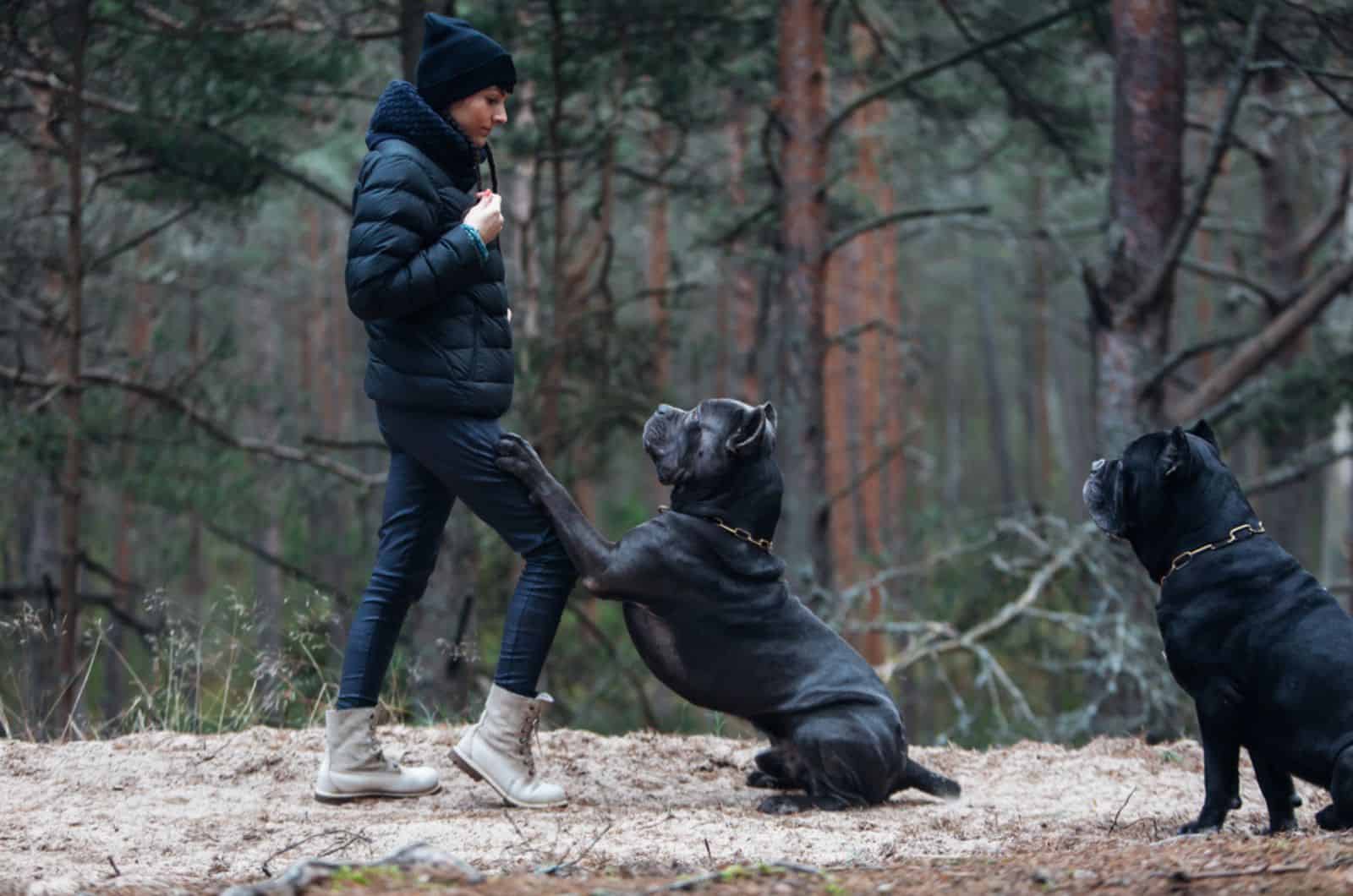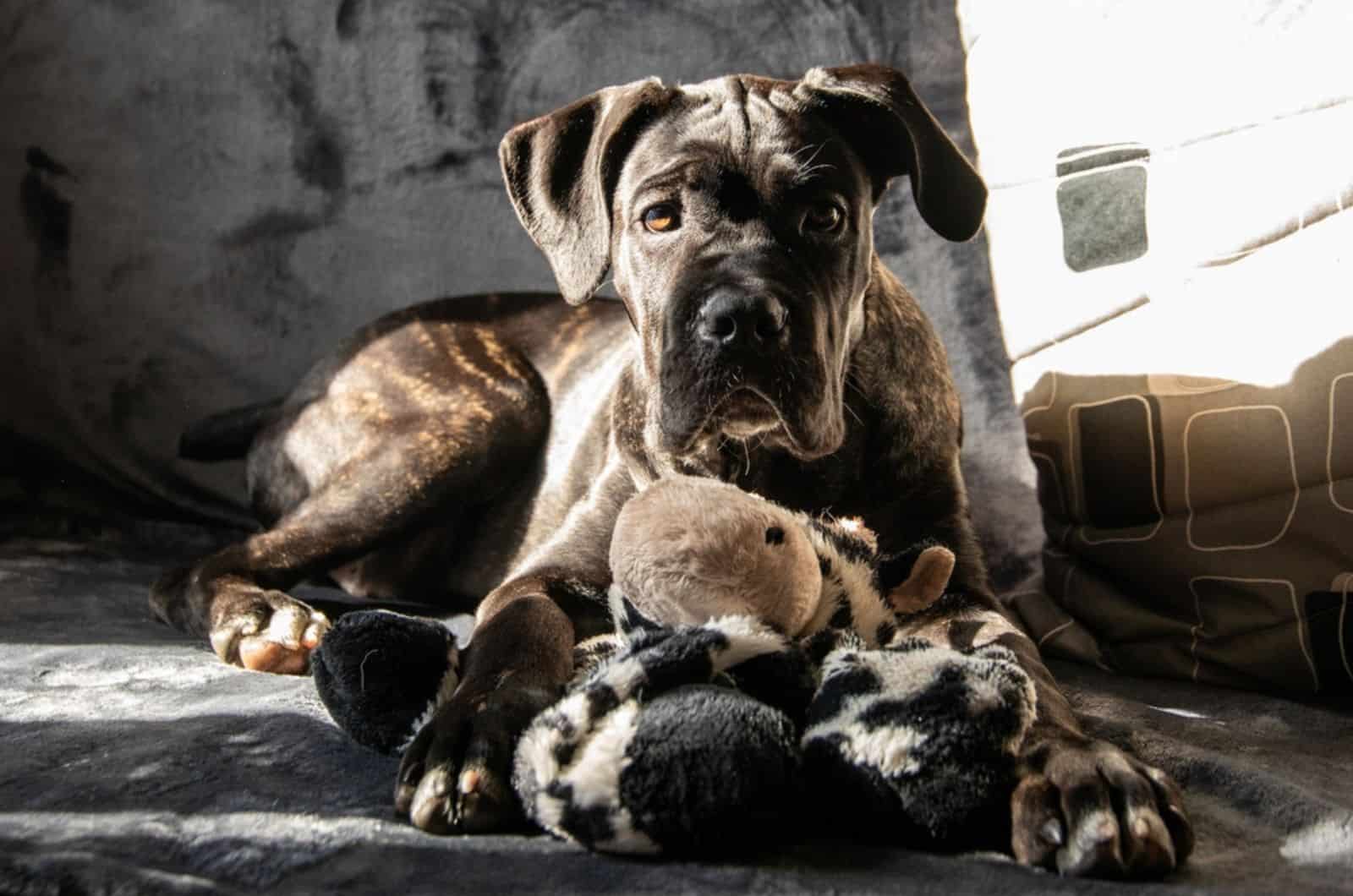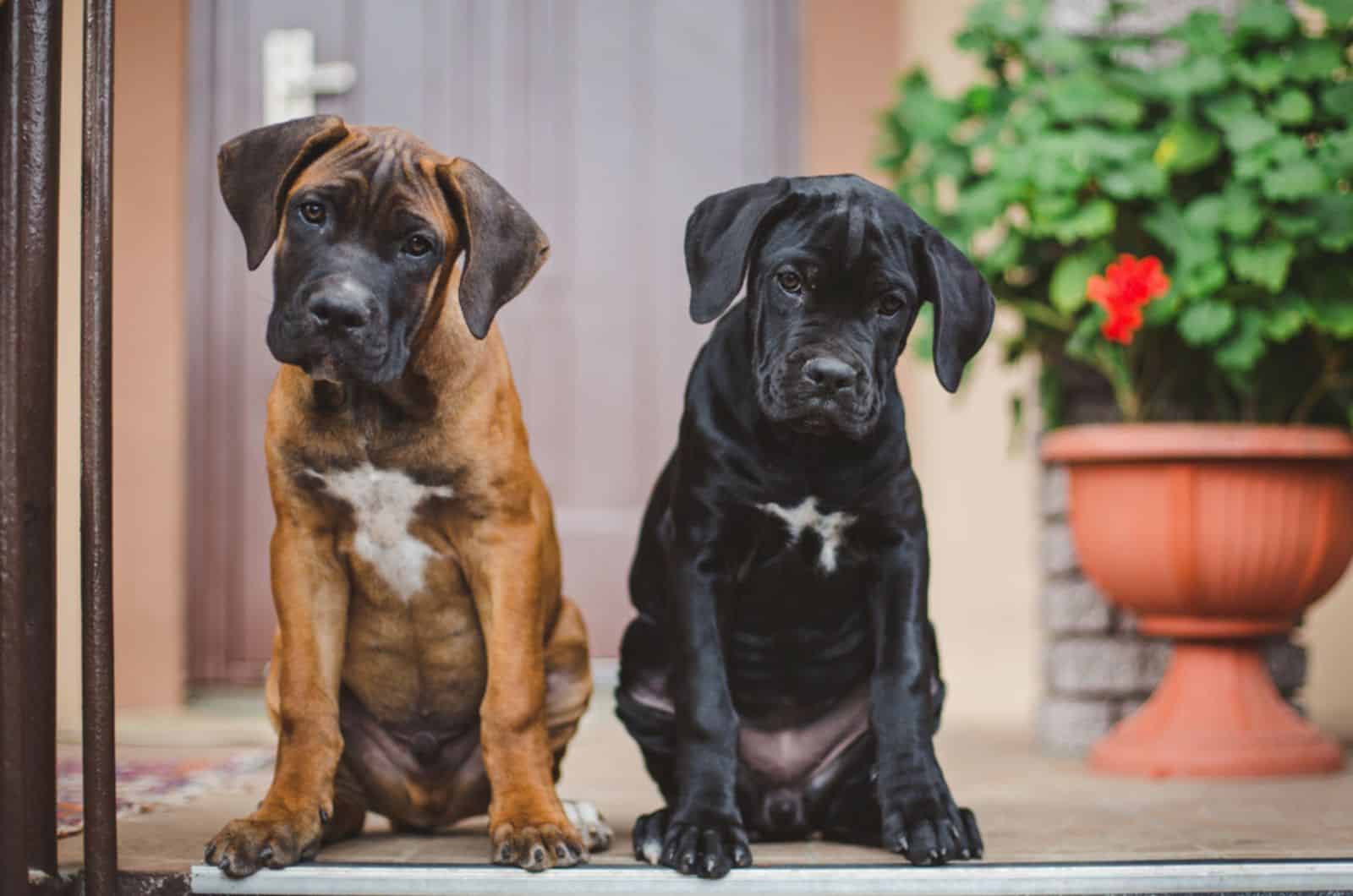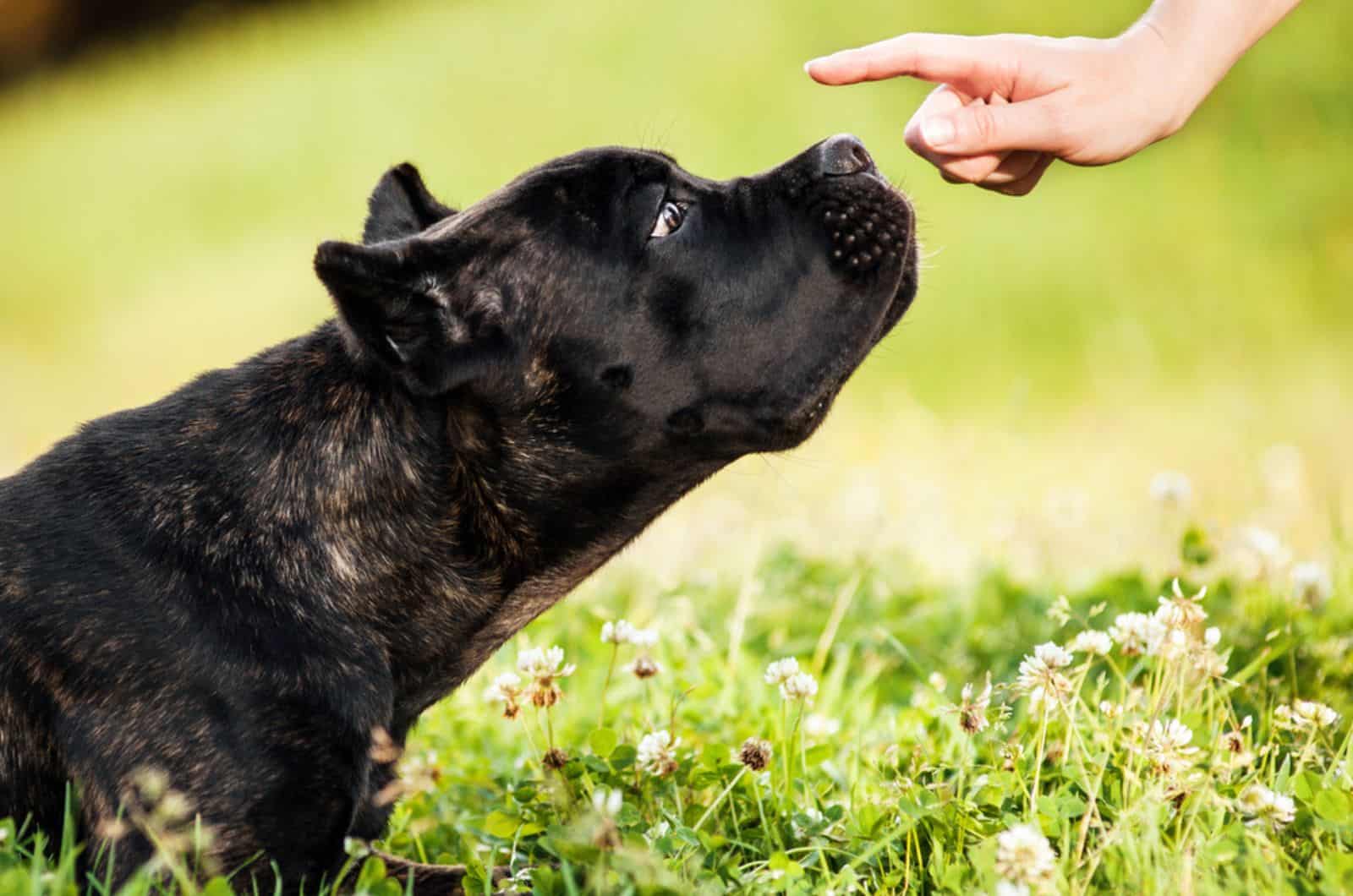It is demanding enough to just get a Cane Corso, let alone train it. If you are in a rut about how to train a Cane Corso, this short guide will get you started and perhaps inspire you to figure out your own training routine.
Good behavior is always desirable in a large breed dog such as the Corso, but its head-strong character and dominant behavior deeply ingrained in the genetics can be too much to handle, especially for first-time dog owners.
While there are many things to go through to get the wanted result in terms of being a good boy, it all boils down to commitment, perseverance, and sticking to a structured routine. Time to absorb some badly needed knowledge.
How To Approach Dog Training With Cane Corsi

There are essentially two “phases” of training with a Cane Corso. To learn how to train a Cane Corso, you have to realize that getting started as soon as the puppy arrives at your home is crucial for a well-behaved adult dog.
Cane Corso puppies will be easier to read and trained into amazing balanced adult dogs. Having a “teenage” dog as the starting point is much more challenging due to its self-confidence and prior habits, so begin training as early as possible.
As an owner, you will have to stay calm, be assertive, and never lose control of the situation. Beware, your authority will be questioned by a Cane Corso.
One thing that is part of every dog breed’s behavior is sniffing out the pecking order. As small and cute as they are, figuring out who is in charge, how they behave, and what their weak points are is their first point of order.
Seeing a Cane Corso on the street can make you think they are of a manageable size, but putting them into the context of an apartment or house really answers the question. Here is a Cane Corso growth chart for reference.
Do not take the hierarchy in your family lightly or the Cane Corso puppy might become the head of the house. It is equally important that the entire family knows the rules on how and when to interact with the dog.
If you spend countless days and weeks learning how to train a Cane Corso but your family undoes the hard work by using a different set of rules while you are not there, it can become hard to eliminate the undesirable behavior.
Keep in mind that corrections are not a negative thing. Letting your dog know that something is wrong is necessary, especially with such a dominant and strong breed as Cane Corsi.
Best Training Methods For A Cane Corso
In dog training, there are usually two schools of thought — those that believe positive reinforcement is the only way to go, and those who use corrective action to convey to the Cane Corso that certain behavior is not desirable.
I am a strong believer that training your dog exclusively with positive reinforcement techniques is not nearly as efficient as using it in conjunction with corrections. You should not mix up the terms punishment and corrective action.
You should never physically or mentally punish your dog as that will show them you are not apt as a leader. A one hundred and sixty-pound Cane Corso will eventually just overpower you both in terms of strength and stubbornness or dominance.
Large dog breeds should be incentivized by their favorite treats and games, but do not forget their stomach will become full, and their brains tired of playing by your rules. That is when you need to switch to pure leadership.
What does that mean? Learning how to train a Cane Corso means you will be expected to decide for the dog where and when you are going. The same goes for other activities that you should be the orchestrator of.
Giving the Cane Corso some free time to do what it likes the most should be a reward. Crate training and potty training should be done to teach your dog a specific sequence of events that result in a reward.
Do not forget that the reward can be anything you set up as a positive experience. That includes treats, playtime, relaxation, or affection. For a Cane Corso, a combination of all these is the best shot at getting good results.
Before Going For Potty And Crate Training

The first impression your Cane Corso puppy should have of you and your family is that its position is last in the pack order. That means you lead everyone, but your family members come before the dog.
How do you teach your dog that? In a primal and instinctive way. You always go first through doors, you always take care of yourself and the family first, and the dog should be taught by example.
Naturally, owners and their families are quite excited when getting a new canine addition to the home, so try and show that you are excited but under control. See for yourself how the Cane Corso fares as a family dog.
Training my dogs has taught me that controlling your emotions does not mean pushing them back, but being calm about the way you express them.
While working with different breeds or even mixed breeds, I realized that each dog has some finesse that requires establishing a personal relationship with them. Even as a dog trainer, you get to know all the dogs personally in a spontaneous manner.
That means that dog owners who have not trained a dog previously need to see the dog as an animal, not a human. Your dog might be the smartest in the world, but it is still an animal and should be approached as one.
A Cane Corso will work mostly based on its instinct and by reading your body language, so make sure you are an upstanding leader before jumping into the intricacies of the crate and potty training.
Crate Training Your Cane Corso
One of the first and most crucial things that will set you up for housebreaking is crate training. Teaching your Cane Corso puppy where its place for relaxation and self-soothing is should not be delayed.
You have to start from day one. Unwanted behavior most often sticks with the dog in its maturity due to giving it free rein around the house. As part of the Italian Mastiffs family, the Cane Corso puppy will be stubborn from the start, so arm yourself with a lot of patience.
Crate Training Must Dos
Crate training serves more than just a designated place for relaxing. It is an indication of pack order. The lower position of the crate compared to the couch or bed shows that you are the leader because of the higher ground.
The crate should not be used for fun and games because it represents calm behavior and sleep time. Keeping the pup in the crate before going to bed will definitely be hard as it will want to be as close to you as possible.
By no means should you allow your Cane Corso puppy to sleep with you as that will be detrimental to your attempt to establish a social hierarchy. If the puppy is refusing to stay in the crate, you can leave a favorite treat inside.
Alternatively, you can use any object with your scent as well. The smell of the owner will have a soothing effect on the Cane Corso puppy. If you have some objects the breeder sent along with the puppy, like a blanket with the puppy’s mother’s scent, use it for now.
Whining and crying is a given with the vast majority of puppies, but you have to ignore that behavior. Jumping out of bed to soothe them completely defeats the purpose of a crate. In a couple of days, your puppy will know you will come whenever it calls.
Things To Avoid When Crate Training
A crate should be open during the day but closed during the night. Never make the crate a form of negative reinforcement or punishment. Bad experiences associated with a crate will be hard to forget or correct later on.
Cane Corsi puppies learn very quickly at the age of eight to ten weeks. Despite being so young, this formative period will be one where your pup will learn most of the basics. Do not close your puppy inside the crate during the day or when you have people over.
No matter how big, confident, or dominant the Cane Corso dog is, being confined in the crate all day will most likely cause it to develop separation anxiety. Unsure about why your puppy dreads the crate? We have just the article for you that gives fourteen reasons why.
Because it is a place to sleep in, the dog will automatically connect the dots that relaxation and comfort are provided inside the crate. You can teach your dog the command “place” to go into the crate, but never in a scolding way.
Everything must be a fun and jolly experience for the dog when you want to assign a word to a desired action. Avoid moving the crate too often as it can stress out the dog. Think through the positioning of the crate before crate training.
Some suggest putting the crate close to your bed so you can have some contact with the puppy in case it starts crying in the crate, but I believe that a puppy should be taught nothing bad will happen if it is left alone during the night.
Potty Training Is Easier Than You Might Think

Consistency when teaching your dog is of paramount importance. Do not change the time, place, or praise words when you are trying to show a dog that it did something good.
A great help for potty training is that you can simultaneously crate and potty train your Cane Corso. Right before going to sleep, you should take your dog on a leash and go outside to potty.
Wait until you see the dog sniffing around for a spot to pee or poop in and say “potty” or any other word you want it to associate with doing the business. After successfully performing the desired action, you should praise it with “good girl/boy” or “good potty”.
Avoid giving treats or playing games after potty, because it will mess up the potty routine by exciting the puppy before bedtime. Immediately after that bring it back into the crate and call it a day. Do not leave it roaming around the yard or house even for a minute.
Cane Corso puppies will have to potty more often than adult dogs. Pooping or peeing inside the house is not the pup’s fault, as you should be aware of when they need to go. The timings are after a meal, after waking up, and right after physical activity.
This is the ideal scenario, but make sure you read their body language and behavior prior to a number one or number two. Definitely keep the puppy in your line of sight while you are in the house. Accidents can happen, but you as the leader should be there to prevent them.
In case you notice things are not going well, have a quick read of this article talking about potty training regression and how to fix it.
Planning out a feeding and sleeping regime will make potty training that much easier because both you and the Cane Corso puppy will know when the right time is. Consistently using “potty” as a word that means the action of peeing and/or pooping will enable potty on command.
Big No-Nos During Potty Training
Setting up ground rules and teaching them keywords at a young age, especially puppyhood, will lower the chances of you getting upset at them because potty training is not going as well as you thought it would.
You will never be able to make a stressed puppy go potty. Yelling, forceful behavior or punishment will set you back weeks, and only one such occasion can topple all the meaningful work you have done.
Do not expect the puppy to poop simply because it just finished eating its meal. Most puppies will need a couple of hours to digest the food. Whining and crying out can be quite annoying, so do not presume it is a sign of needing to potty.
You will have to learn the difference between excitement and nature’s calling. With most dog breeds, including Cane Corsi, you will be able to discern how their ears are positioned, or simply by the movement inside the crate or house.
Doing potty inside the crate is a bad habit no matter how well you clean it. Most dogs will exhibit behavioral problems later on if they get used to poping and peeing inside the crate. It should be very clear to the puppy what exactly the potty area is.
Basic Obedience Training
One of the most basic commands every owner needs to know, and know how to use are the heel, recall command, name association, sit, down, and a release command.
Most commands can be taught with treats while the puppy or young dog still has a strong food drive. If your Cane Corso shows a strong natural prey drive, then a game of tug-of-war might be more fun than eating food.
Still, it is best to incentivize the dog with treats before eating a full meal. You will find that training sessions will be short overall, but particularly so after eating. Here are eight scrumptious treats for Cane Corsi that ought to do the job.
You can use a clicker to signal the dog that treats are coming, but the timing has to be perfect. If you are trying to teach it to come to you when the word “come” is spoken, as soon as the dog is near your leg you should click once and give a reward.
It will take some time before the dog realizes it is much better to stick with you than wander around. The same principle can be applied to all commands using a clicker. You can also use words like “good” or “yes” instead of a click, or make a clicking sound with your mouth.
Name Association
If you brought in the Cane Corso puppy as a new dog and you have one or more dogs in your house already, teaching the name is incredibly important. You will want to train them as a wolf pack, but also to understand when a command is directed to each individual dog.
As always, directing attention toward you is the first step. You want to teach the dog to make eye contact with you when you say its name. Kneel down so that the distance between your and the dog’s eyes is not that far.
Take a treat in your hand and make sure the dog knows it is there. Then, make a motion from the dog’s nose to your eyes while the treat is in the hand. Stop so that the treat is right in front of your nose, making it appear as though the dog has established eye contact.
You have to react fast once the dog is looking at you and reward it. Giving out treats a couple of seconds after eye contact will make it harder for the dog to understand what exactly prompted the reward.
Make the sessions nice and short so that the dog does not get too bored. Under half an hour should be more than enough if you do more than one command in that timeframe.
Release Command
A release command means that you are dismissing your dog from the current action associated with the last given command. If you, for example, say “sit” and the dog sits, and then you command it to “stay” it will remain in place (hopefully).
To release the dog from the “stay” command, you can use “ok”. Saying okay will mean that the dog is free to do whatever it wants unless you follow it up with some other command. This is mostly used once your puppy knows the basic commands.
Make sure you teach it early to your puppy or the adult Cane Corso might completely disregard it later on.
No Command Means Unwanted Behavior
If you are teaching your Cane Corso to stay and it simply stands up once you take a step away, you should say “no” as a marker of undesired behavior. Be clear and loud because mumbling out commands or repeating them will make the dog think you do not have it in you.
As with most commands, you can use any word you like to associate with a certain action, but it is important that the “no” command is something unmistakable and short. That is because you will need to quickly say it after the dog does something unwanted.
Heel Commands Take Patience
One of the main things every owner should teach their dog(s) is to heel. Not only is it a way to keep your dog near you, but it makes leash walking a breeze.
Holding out your hand by the side with a treat snuggly in it will make it follow you right on the leg. You can teach your dog to heel on one side only. Consistency will make it easier for the dog to understand what is asked of it.
You can use any dog food for training commands, but if treats become boring to your Cane Corso, some stripes of chicken or hot dog can be a saving grace.
Make sure the dog’s head is aligned with the front side of your thigh. That way it will not pull in front of you and will be compactly set by your leg without hindering your walk.
Ideally, when you give out the heel command, the dog should immediately align the head in the proper position and follow your walking pace. Whenever this happens you should click or say “good” to mark a wanted behavior.
Immediately after, reward the dog with food or by giving it its favorite chew toy. When your dog becomes tired of training and stops responding to your commands, you can correct it by gently pulling the leash with a quick motion.
Do not keep the leash tense. It should be a snappy move to redirect your dog toward where you are going. That is how to train a Cane Corso to behave during a walk. If you think the collar is the problem, have a look at the twelve best Cane Corso collars.
The Sit And Down Command
You can approach the “sit” command in two ways. One way is to try without physically pushing the dog’s rear into a sit position, or put the treat over its head so that the dog’s head commands the butt to go down.
Since Cane Corsi are stubborn dogs, you might have to use a combination of the two. If the reward is not appealing enough, they might ignore you completely. Using the leash to prevent your dog from running away, gently press on the lower back area with two fingers.
You will have to take into consideration the time of day, the tiredness of the dog, etc. when teaching commands. The earlier you start after the puppy wakes up, the greater the chances you will make a lot of progress.
The “down” command can be tricky for dogs that are stubborn. Depending on the individual dog, you might succeed on the first attempt, or you might have to use the leash and treat in conjunction.
Essentially, you will want to hold the treat firmly in your hand and put it on the ground. The only way your Cane Corso will be able to nibble it out is by lying down. Alternatively, you can pull the leash down. Remember that the head controls the movement of the entire body.
Check out this video down below for a visual representation of how to train a Cane Corso to sit or down.
Socialization And Protection Training
I cannot stress how important socialization is for dominant, highly protective, large-breed guard dogs. You can train it to change a light bulb, but still have a poorly behaving dog in real-world scenarios.
Going to the dog park, meeting people outside, strollers, bikes, traffic, and all different kinds of sounds and visual elements can stress your dog. Even if you are stressed, your dog will catch on to the body language and act fearful or protective.
While still a puppy, your Cane Corso should be exposed to as many things as possible. Make sure it knows how to behave with other dogs, guests, children, and other animals (cats, guinea pigs, etc.).
Show it that a bike or stroller is not dangerous, and that not every unknown person presents a danger to its family. The more experiences it absorbs, the better it will understand how the world around it works.
A confident, domineering, and large dog with plenty of knowledge about everything that surrounds it will be a better guard dog than a fearful or anxious one. Read our article answering the question of aggression in Cane Corsi for a better overview of the temperament.
Can You Train A Cane Corso For Protection?
Of course, you can have your Cane Corso go through protection training, but you alone cannot do it. Only certified professionals can do this job, simply because of the facilities, programs, and sheer experience in the business.
Most families do not need protection training for a Cane Corso due to the breed’s incredible protective instinct. A well-socialized and obedience-trained Cane will be an excellent watchdog/ guard dog.
Keep in mind that these services are expensive and will require some effort from your side as well.
Conclusion
So, that is how to train a Cane Corso to potty and use the crate with the addition of a few basic commands. It is not hard as long as you do not give up easily.
I have grown so patient working with dogs that even people rarely annoy me now. As dog owners, we should constantly work to better our dogs’ mental and physical health, and training is a big part of the process.
Do obedience training every day. Start with a warm-up of simple stuff and build toward complex things like recognizing different objects, doing some strength work, etc. A Cane Corso is perhaps not as trainable as a Belgian Malinois, but you can still achieve impressive results.
No matter what command you are teaching your dog, it is important you do not humanize the dog. Be gentle but determined in every command you say and action you perform. And make sure you know what are the pros and cons of owning a male vs female Cane Corso first.
